DOI: https://doi.org/10.1038/s41598-023-50000-y
PMID: https://pubmed.ncbi.nlm.nih.gov/38200086
تاريخ النشر: 2024-01-10
افتح
نهج جديد في تقييم المخاطر الصحية البشرية المرتبطة بالمعادن الثقيلة في المياه السطحية والمياه الجوفية باستخدام طريقة مونت كارلو
الملخص
تقييمت هذه الدراسة المخاطر البيئية والصحية المرتبطة بالمعادن الثقيلة في موارد المياه في صحراء مصر الشمالية الغربية. شملت الأساليب الحالية مصفوفة ارتباط سبيرمان، وتحليل المكونات الرئيسية، وتحليل التجمع لتحديد مصادر التلوث وعوامل التحكم في الجودة. تم تطبيق مؤشرات مختلفة (HPI، MI، HQ، HI، وCR) لتقييم المخاطر البيئية وصحة الإنسان. بالإضافة إلى ذلك، تم استخدام طريقة مونت كارلو لتقييم المخاطر السرطانية وغير السرطانية بشكل احتمالي عبر طرق التعرض الفموي والجلدي لدى البالغين والأطفال. من الجدير بالذكر أن جميع موارد المياه أظهرت مخاطر تلوث عالية مع قيم HPI وMI تتجاوز الحدود المسموح بها (HPI>100 وMI>6) على التوالي. علاوة على ذلك، أشارت قيم HI الفموية إلى مخاطر غير سرطانية كبيرة لكل من البالغين والأطفال، بينما شكل الاتصال الجلدي خطرًا كبيرًا على
المواد والأساليب
وصف منطقة الدراسة
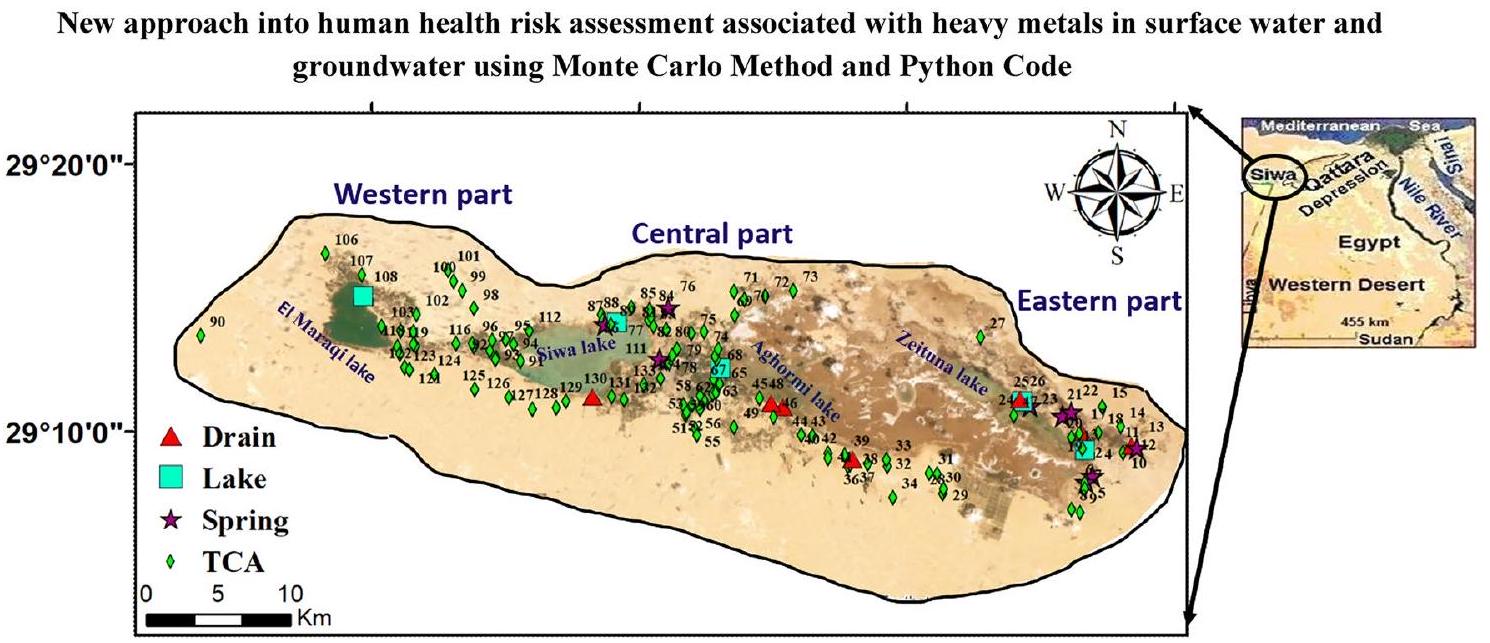
جيولوجيا وموارد المياه في منخفض سيوة
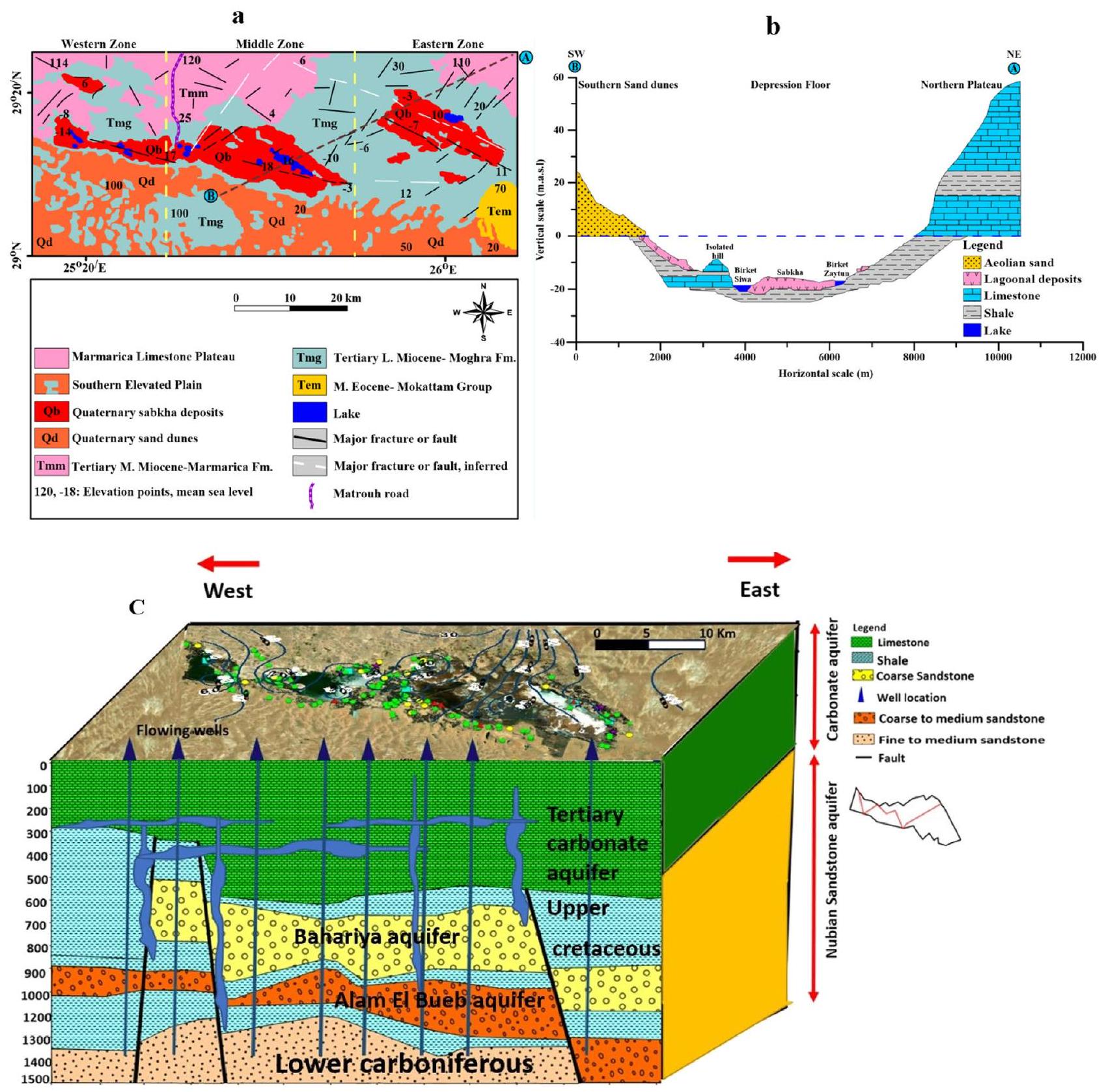
أخذ العينات وتحليل المعلمات الفيزيائية والكيميائية والمعادن الثقيلة
تحليل العنقود (CA)
تحليل المكونات الرئيسية (PCA)
مؤشر تلوث المعادن الثقيلة (HPI) ومؤشر المعادن (MI)
تقييم مخاطر الصحة البشرية
| إتش إم | سي دي | كر | نحاس | حديد | من | ني | الرصاص | زن | المراجع |
| RfD عن طريق الفم (ملغ/كغ/يوم) | 0.0005 | 0.003 | 0.04 | 0.7 | 0.024 | 0.02 | 0.0014 | 0.3 | ٤٥ |
| ABS | 0.05 | 0.025 | 0.3 | 0.2 | 0.04 | 0.04 | 0.3 | 0.2 | ٤٦ |
| Rfd جلدي (ملغ/كغ/يوم) | 0.000025 | 0.000075 | 0.012 | 0.14 | 0.00096 | 0.0008 | 0.00042 | 0.06 | ٤٧ |
| CSF عن طريق الفم ملغ/كغ/يوم | 6.1 | 0.5 | 0.5 | ٤٨ | |||||
| CSF الجلدية | 6100 | ٥٠٠ | ٥٠٠ | ٤٨ | |||||
| كر | 0.001 | 0.002 | 0.001 | 0.001 | 0.001 | 0.0002 | 0.0001 | 0.0006 | ٤٩ |
| نعم | 0.003 | 0.05 | ٣ | 0.3 | 0.05 | 0.07 | 0.01 | 1 | 50 |
| ET بالغ (ساعة/يوم) | 0.58 | 51 | |||||||
| ET طفل (ساعة/يوم) | 1 | 51 | |||||||
| SA بالغ (سم²) | 18,000 | ٤٦ | |||||||
| SA طفل (سم²) | 6600 | ٤٦ | |||||||
| CF (ل/سم³) | 0.001 | 51 | |||||||
| IR بالغ (لتر/يوم) | 2.2 | ٤٧ | |||||||
| طفل IR (لتر/يوم) | 1.8 | ٤٧ | |||||||
| EF (يوم/سنة) | ٣٥٠ | 42 | |||||||
| ED البالغين (سنة) | 70 | ٤٦ | |||||||
| طفل التعليم المبكر (السنة) | ٦ | ٤٦ | |||||||
| وزن البالغ (كجم) | 70 | 52 | |||||||
| وزن الطفل (كجم) | 15 | 52 | |||||||
| AT بالغ (يوم) | ٢٥,٥٥٠ | 53 | |||||||
| طفل في النهار | ٢١٩٠ | 53 |
يمكن التعبير عن خطر السرطان (CR) الناتج عن الهضم المباشر والاتصال بالجلد على النحو التالي:
محاكاة مونت كارلو
النتائج والمناقشة
المعلمات الفيزيائية والكيميائية
تراوحت قيم المواد الصلبة الذائبة الكلية (TDS) في عينات المياه المدروسة بين
| المعلمات | من | ماكس | معنى | SD |
| درجة الحموضة | 6.8 | ٨.٧ | 7.9 | 0.3 |
| الضريبة المقتطعة عند المصدر | 1120 | 153,589 | 9834.1 | ٢٠٧٠١.٩ |
|
|
٣.٥ | 83 | 42.8 | 18.5 |
|
|
192 | ٣٩٥٠٠ | 2240.9 | ٥٥٣١.٦ |
|
|
9 | ١٢٢١٦.٦ | 676.6 | ١٣٨٨.٨ |
|
|
19.6 | ٢٥٠٨.٨ | ٣٦٦.٥ | 401 |
|
|
580 | ٩٤٢٥٠ | ٥٩٣٣.٩ | 13,042.3 |
|
|
٥ | 5348.7 | ٤٨٦.٦ | 652.4 |
|
|
٨٣.٧ | ٣٢٨.٨ | ١٦٦.٧ | ٣٦.٥ |
|
|
0 | ٣٥.٣ | 6.2 | ٨.٨ |
| سي دي | 0.002 | 0.19 | 0.04 | 0.03 |
| كر | 0.0015 | 12.3 | 0.6 | 1.63 |
| نحاس | 0.002 | 15.6 | 1.14 | ٣.٠٠٤ |
| حديد | 0.003 | ٣٦.٢ | 2.16 | 5.35 |
| من | 0.0002 | 3.37 | 0.28 | 0.68 |
| ني | 0.0001 | 0.72 | 0.1 | 0.12 |
| الرصاص | 0.002 | ٢.٢٣ | 0.33 | 0.34 |
| زن | 0.0002 | 0.1 | 0.03 | 0.024 |
أصل المياه السطحية والمياه الجوفية
العمليات الجيوكيميائية التي تتحكم في كيمياء المياه
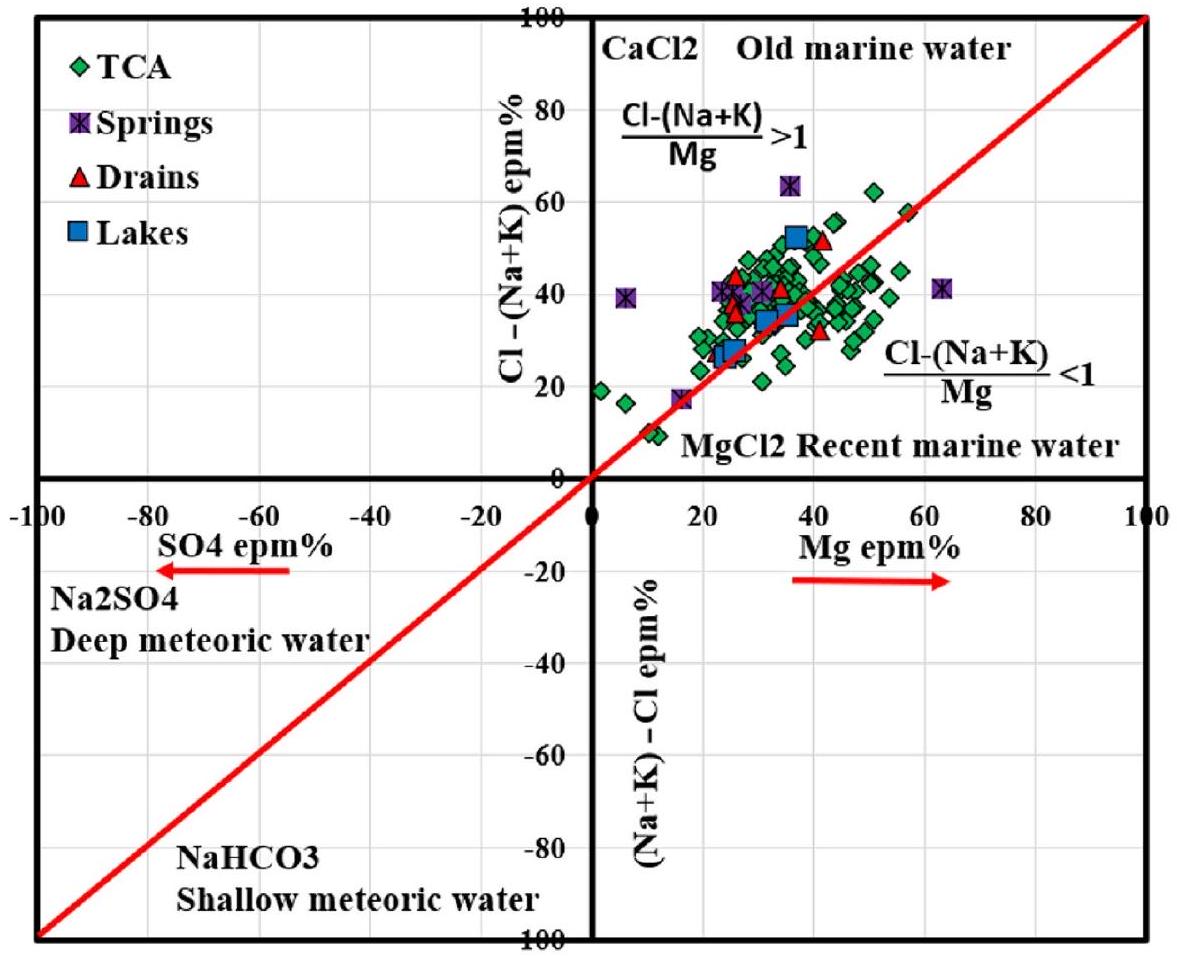
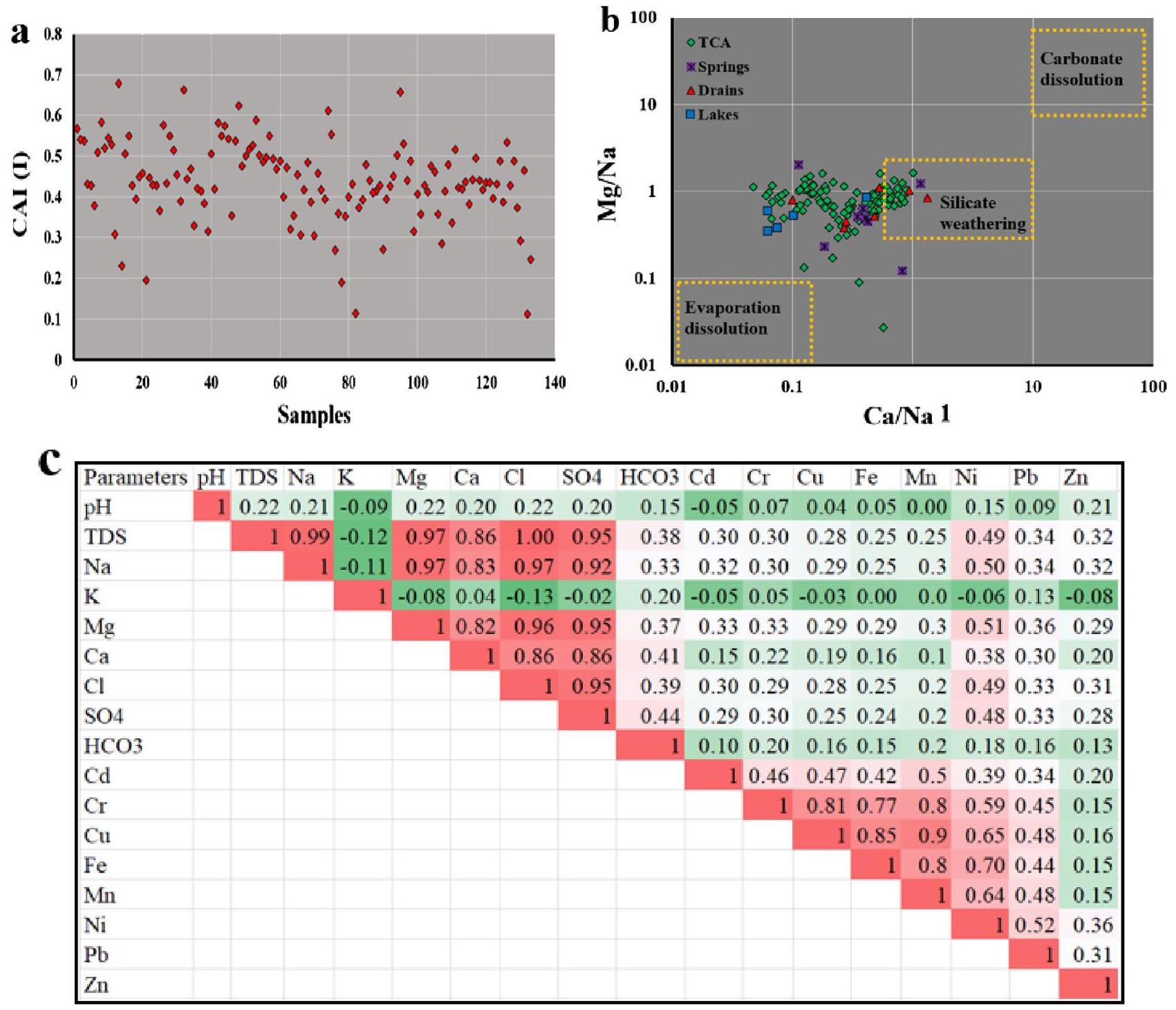
المستويات. وفقًا للمعادن الثقيلة، يكشف التحليل عن مساهمة من أنشطة بشرية متنوعة في منطقة الدراسة. تشمل هذه الأنشطة ممارسات الزراعة، وطرق الصرف الصحي غير المناسبة، والتصريف من مصادر مثل التحلل العضوي. تؤدي هذه الأنشطة التي يقوم بها البشر إلى إطلاق المعادن الثقيلة في موارد المياه في واحة سيوة.
تحليل التجمع للمعلمات الفيزيائية والكيميائية والمعادن الثقيلة
تحليل المكونات الرئيسية (PCA)
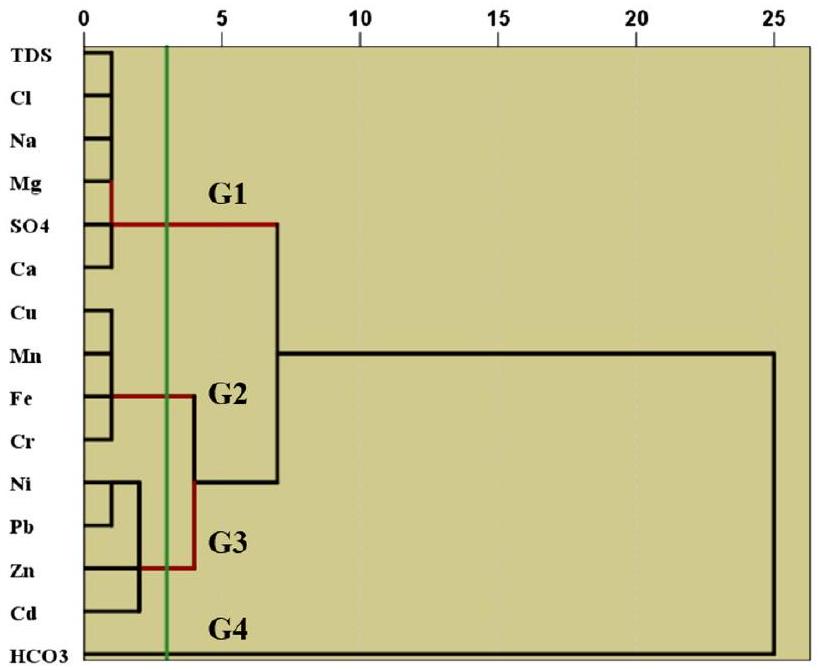
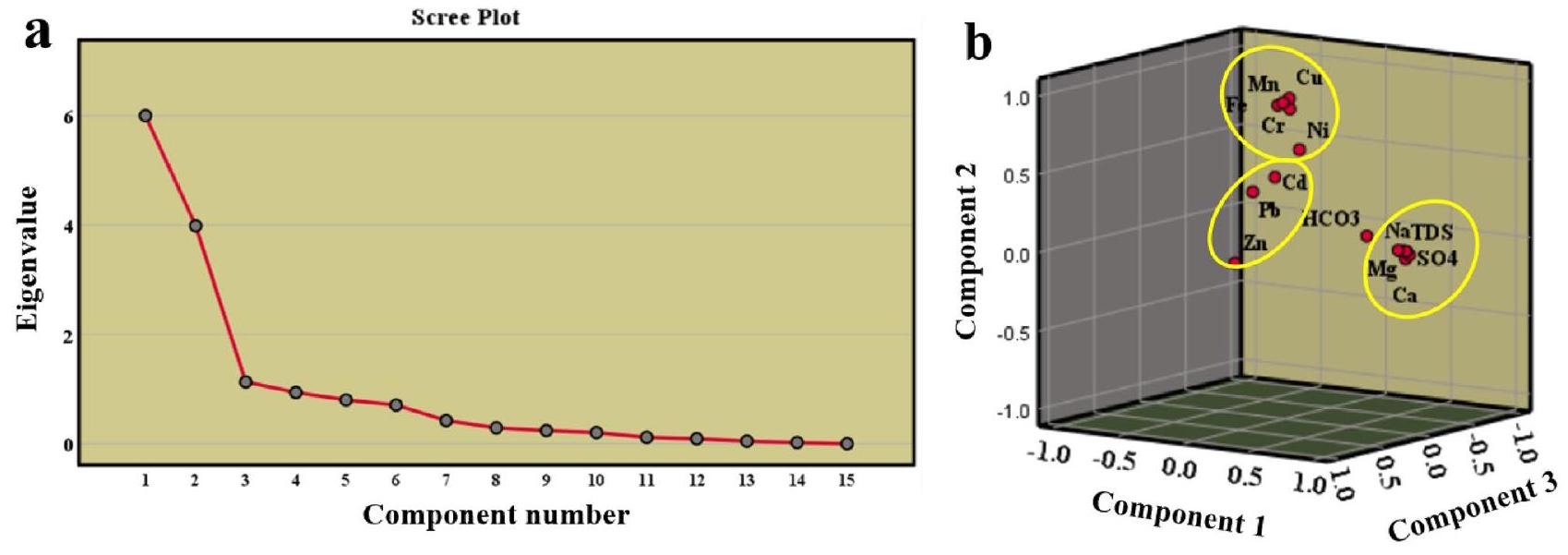
| المعلمات | PC1 | PC2 | PC3 |
| TDS | 0.984 | 0.068 | 0.076 |
| Na | 0.958 | 0.079 | 0.122 |
| Mg | 0.962 | 0.069 | 0.069 |
| Ca | 0.884 | -0.01 | -0.064 |
| Cl | 0.978 | 0.066 | 0.064 |
| SO4 | 0.958 | 0.033 | 0.002 |
| HCO3 | 0.341 | 0.031 | -0.415 |
| Cd | 0.091 | 0.476 | 0.238 |
| Cr | -0.02 | 0.856 | -0.084 |
| Cu | 0.032 | 0.94 | -0.004 |
| Fe | -0.063 | 0.885 | -0.013 |
| Mn | 0.005 | 0.914 | 0.026 |
| Ni | 0.326 | 0.686 | 0.304 |
| Pb | 0.103 | 0.421 | 0.498 |
| Zn | 0.173 | 0.015 | 0.794 |
| القيم الذاتية | 6 | 3.9 | 1.1 |
| % من التباين | 40 | 26.5 | 7.5 |
| النسبة التراكمية % | 40 | 66.5 | 74.1 |
دور حاسم في تحلل المواد العضوية ودورة المغذيات
مؤشر تلوث المعادن الثقيلة (HPI) ومؤشر المعادن (MI)
| معايير | من | ماكس | معنى | نطاق | فصل | العينات (%) |
| مي | 6.5 | 462 | 72.3 |
|
نظيف جداً | 0 (0%) |
|
|
نظيف | 0 (0%) | ||||
|
|
متأثر جزئيًا | 0 (0%) | ||||
|
|
متأثر بشكل معتدل | 0 (0%) | ||||
|
|
تأثر بشدة | 0 (0%) | ||||
| MI>6 | تأثر بشدة | ١٣٣ (١٠٠٪) | ||||
| HPI | 111.7 | ٧٢٧٤.٥ | 1702.9 | <25 | ممتاز | 0 (0%) |
| ٢٦-٥٠ | جيد | 0 (0%) | ||||
| 51-75 | فقير | 0 (0%) | ||||
| 76-100 | فقير جداً | 0 (0%) | ||||
| > 100 | غير مناسب | ١٣٣ (١٠٠٪) | ||||
| HI بالغ (فموي) | 1.6 | ١٤٢.١ | 14.04 | <1 | مخاطر منخفضة | 0 (0%) |
| >1 | مخاطر عالية | ١٣٣ (١٠٠٪) | ||||
| مرحبًا طفل (شفهي) | 6.2 | 542.6 | 53.6 | <1 | مخاطر منخفضة | 0 (0%) |
| >1 | مخاطر عالية | ١٣٣ (١٠٠٪) | ||||
| هاي بالغ (جلدي) | 0.07 | ٤٧.٨ | 2.6 | <1 | مخاطر منخفضة | ١٠٨ (٨٠.٦٪) |
| >1 | مخاطر عالية | ٢٦ (١٩.٤٪) | ||||
| مرحبا طفل (جلدي) | 0.2 | 141 | ٧.٧ | <1 | مخاطر منخفضة | 30 (22.4%) |
| >1 | مخاطر عالية | ١٠٣ (٧٧.٦٪) | ||||
| CRCd البالغ (عن طريق الفم) | 0.0003 | 0.03 | 0.007 |
|
مقبول | 30 (22.4%) |
|
|
مخاطر عالية | ١٠٣ (٧٧.٦٪) | ||||
| CRCr للبالغين (عن طريق الفم) | 2.26E-05 | 0.18 | 0.009 |
|
مقبول | 5 (3.7%) |
|
|
مخاطر عالية | 128 (96.3%) | ||||
| CRPb للبالغين (عن طريق الفم) | ٣.١٦ × ١٠^-٥ | 0.03 | 0.005 |
|
مقبول | 2 (1.5%) |
|
|
مخاطر عالية | 131 (98.5%) | ||||
| طفل CRCd (عن طريق الفم) | 0.001 | 0.1 | 0.03 |
|
مقبول | 0 (0%) |
|
|
مخاطر عالية | ١٣٣ (١٠٠٪) | ||||
| طفل CRCr (شفوي) |
|
0.7 | 0.03 |
|
مقبول | 2 (1.5%) |
|
|
مخاطر عالية | 131 (98.5%) | ||||
| طفل CRPb (عن طريق الفم) | 0.0001 | 0.1 | 0.02 |
|
مقبول | 0 (0%) |
|
|
مخاطر عالية | ١٣٣ (١٠٠٪) | ||||
| CRCd البالغ (جلدي) | 0.002 | 0.2 | 0.04 |
|
مقبول | 0 (0%) |
|
|
مخاطر عالية | ١٣٣ (١٠٠٪) | ||||
| CRCr البالغ (جلدي) | 0.0002 | 1.7 | 0.08 |
|
مقبول | 0 (0%) |
|
|
مخاطر عالية | ١٣٣ (١٠٠٪) | ||||
| CRPb للبالغين (جلدي) | 1.5E-05 | 0.01 | 0.002 |
|
مقبول | 7 (5.3%) |
|
|
مخاطر عالية | 126 (94.7%) | ||||
| طفل CRCd (جلدي) | 0.005 | 0.5 | 0.1 |
|
مقبول | 0 (0%) |
|
|
مخاطر عالية | ١٣٣ (١٠٠٪) | ||||
| طفل CRCr (جلدي) | 0.0006 | 5.2 | 0.2 |
|
مقبول | 0 (0%) |
|
|
مخاطر عالية | ١٣٣ (١٠٠٪) | ||||
| طفل CRPb (جلدي) |
|
0.04 | 0.007 |
|
مقبول | 3 (2.2%) |
|
|
مخاطر عالية | 130 (97.8%) |
تقييم مخاطر الصحة
خطر صحي غير مسرطن


خطر صحي مسرطن (CR)
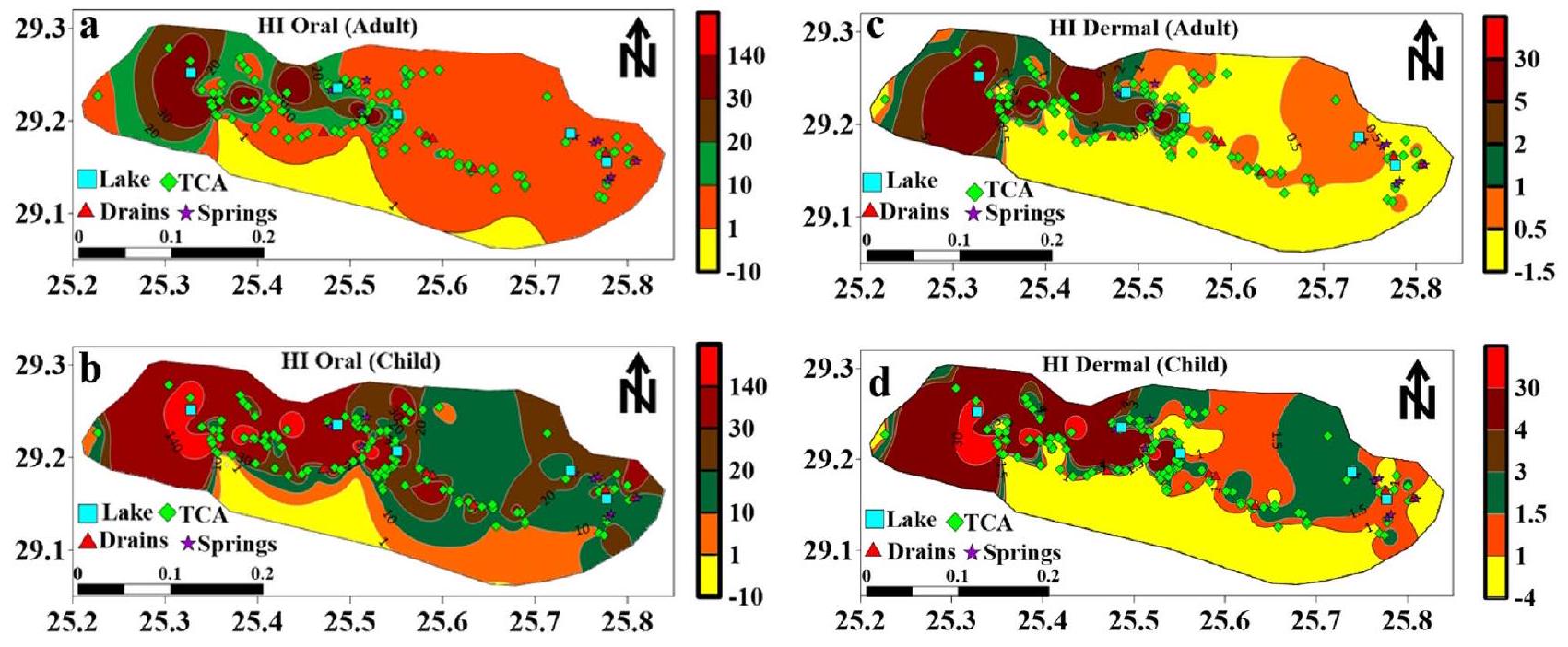
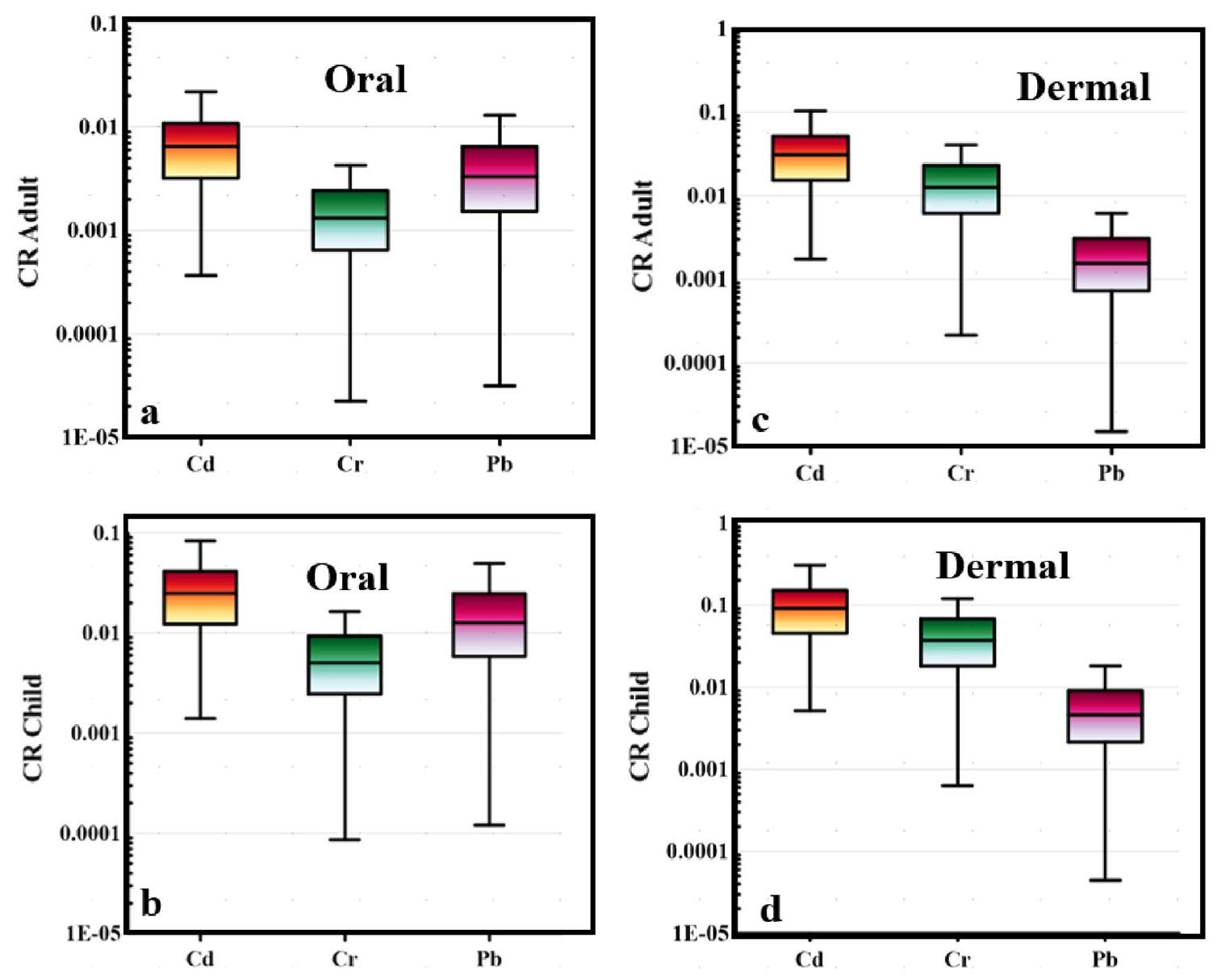
نهج محاكاة مونت كارلو
خطر صحي غير مسرطن
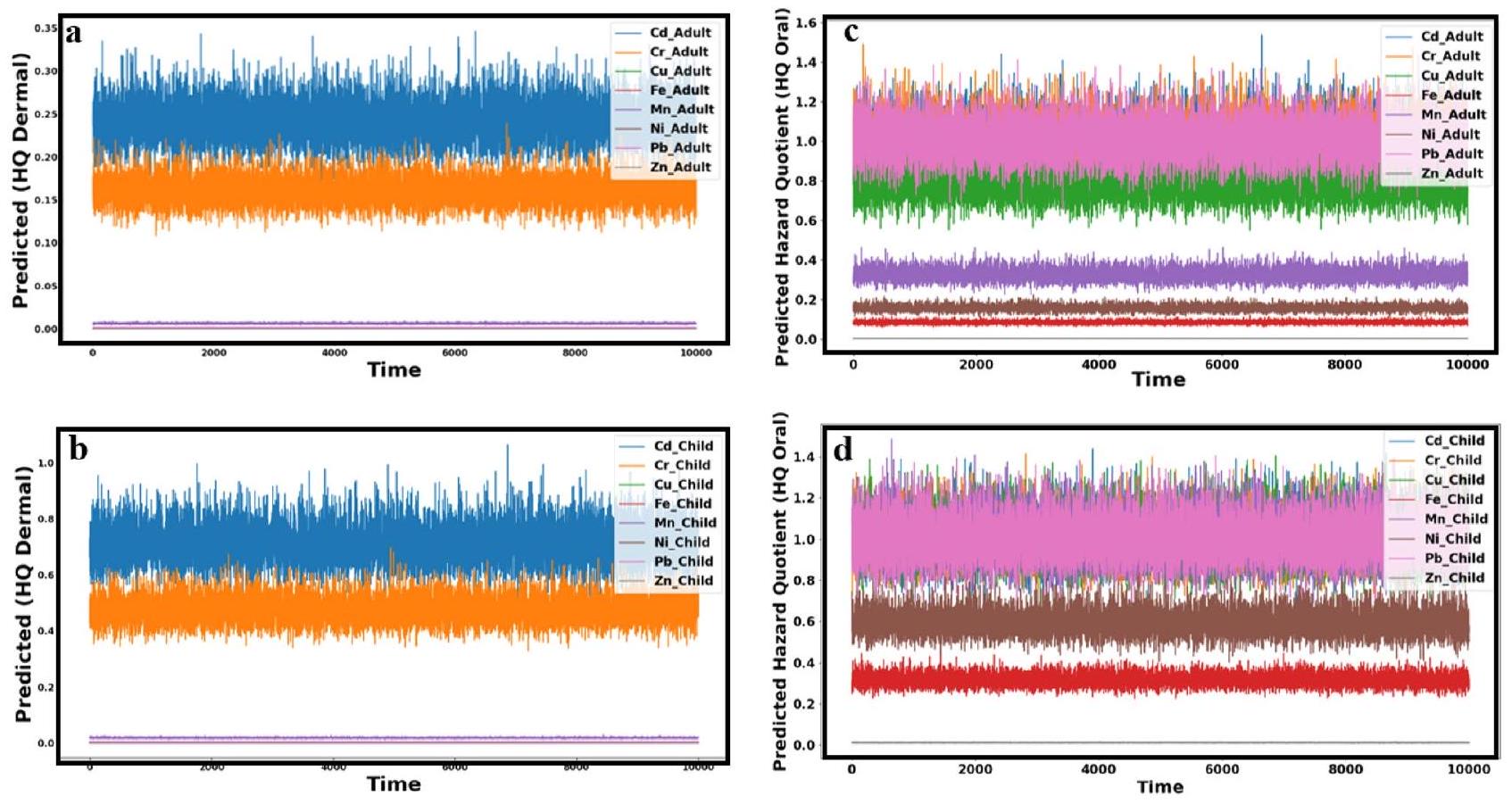
خطر صحي مسرطن من خلال الاتصال الفموي

خطر صحي مسرطن من خلال الاتصال الجلدي
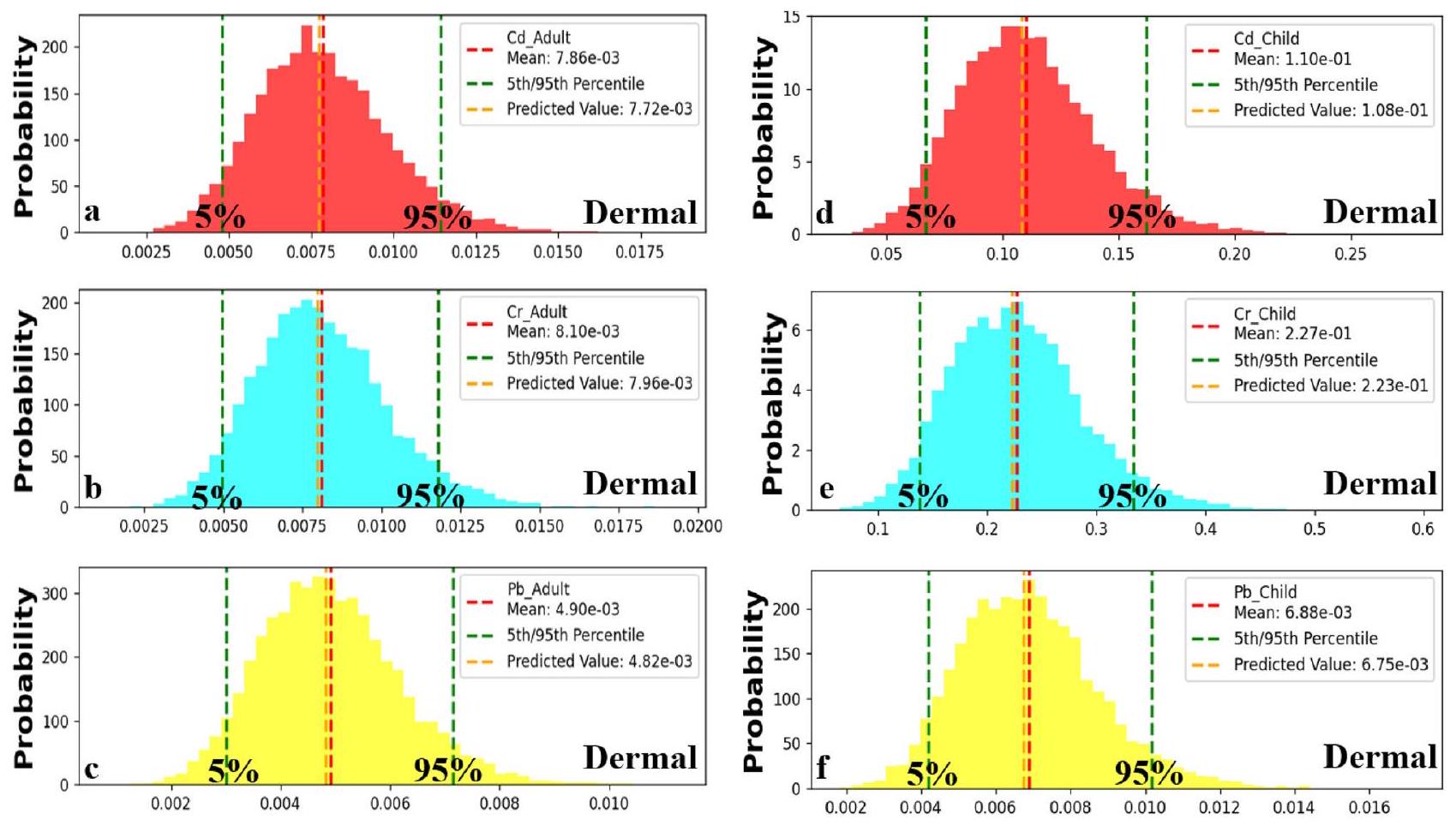
الخاتمة
التأثيرات الصحية المسرطنة وغير المسرطنة من خلال تقليل مدة التعرض. أظهرت هذه النتيجة أن طريقة مونت كارلو هي أداة فعالة يجب تطبيقها جنبًا إلى جنب مع الحساب التقليدي لمؤشرات المخاطر الصحية لتقليل عدم اليقين وزيادة موثوقية النتائج.
توفر البيانات
نُشر على الإنترنت: 10 يناير 2024
References
- Kiani, B. et al. Association between heavy metals and colon cancer: an ecological study based on geographical information systems in North-Eastern Iran. BMC Cancer 21, 414 (2021).
- Mohammadpour, A., Motamed-Jahromi, M., Moreno-Jiménez, E., Golaki, M. & Berizi, E. Novel modelling approach to assess elements contamination in drinking water from Southern Iran. Expo Health https://doi.org/10.1007/s12403-023-00584-7 (2023).
- Soleimani, A. et al. Health risk assessment and spatial trend of metals in settled dust of surrounding areas of Lake Urmia, NW Iran. Int. J. Environ. Anal. Chem. 1-14 (2022) https://doi.org/10.1080/03067319.2022.2032013.
- Jafarzadeh, N. et al. Non-carcinogenic risk assessment of exposure to heavy metals in underground water resources in Saraven, Iran: Spatial distribution, monte-carlo simulation, sensitive analysis. Environ. Res. 204, 112002 (2022).
- Kubier, A., Wilkin, R. T. & Pichler, T. Cadmium in soils and groundwater: A review. Appl. Geochem. 108, 104388 (2019).
- Badeenezhad, A. et al. Comprehensive health risk analysis of heavy metal pollution using water quality indices and Monte Carlo simulation in R software. Sci. Rep. 13, 15817 (2023).
- Chowdhary, P., Bharagava, R. N., Mishra, S. & Khan, N. Role of Industries in Water Scarcity and Its Adverse Effects on Environment and Human Health. in Environmental Concerns and Sustainable Development (eds. Shukla, V. & Kumar, N.) 235-256 (Springer Singapore, 2020). https://doi.org/10.1007/978-981-13-5889-0_12.
- Badeenezhad, A. et al. Effect of land use changes on non-carcinogenic health risks due to nitrate exposure to drinking groundwater. Environ. Sci. Pollut. Res. 28, 41937-41947 (2021).
- Mohammadpour, A. et al. Trace elements human health risk assessment by Monte Carlo probabilistic method in drinking water of Shiraz, Iran. Int. J. Environ. Sci. Technol. 20, 3775-3788 (2023).
- Kiani, A. et al. Accumulation and human health risk assessment of nitrate in vegetables irrigated with different irrigation water sources- transfer evaluation of nitrate from soil to vegetables. Environ. Res. 205, 112527 (2022).
- Rehman, K., Fatima, F., Waheed, I. & Akash, M. S. H. Prevalence of exposure of heavy metals and their impact on health consequences. J. Cell. Biochem. 119, 157-184 (2018).
- Ogamba, E. N., Charles, E. E. & Izah, S. C. Distributions, pollution evaluation and health risk of selected heavy metal in surface water of Taylor creek, Bayelsa State, Nigeria. Toxicol. Environ. Health Sci. 13, 109-121 (2021).
- Jafari, A., Ghaderpoori, M., Kamarehi, B. & Abdipour, H. Soil pollution evaluation and health risk assessment of heavy metals around Douroud cement factory, Iran. Environ Earth Sci. 78, 250 (2019).
- Gad, M. et al. Groundwater quality and health risk assessment using indexing approaches, multivariate statistical analysis, artificial neural networks, and GIS techniques in El Kharga Oasis, Egypt. Water 15, 1216 (2023).
- Ritter, Keith Solomon, Paul Sibley, L. Sources, pathways, and relative risks of contaminants in surface water and groundwater: a perspective prepared for the Walkerton inquiry. J. Toxicol. Environ. Health, Part A 65, 1-142 (2002).
- Kazemi Moghaddam, V. et al. Heavy metal contaminated soil, water, and vegetables in northeastern Iran: potential health risk factors. J. Environ. Health Sci. Eng. 20, 65-77 (2022).
- Jafarzade, N. et al. Viability of two adaptive fuzzy systems based on fuzzy c means and subtractive clustering methods for modeling Cadmium in groundwater resources. Heliyon 9, e18415 (2023).
- Shams, M. et al. Heavy metals exposure, carcinogenic and non-carcinogenic human health risks assessment of groundwater around mines in Joghatai, Iran. Int. J. Environ. Anal. Chem. 102, 1884-1899 (2022).
- Mohammadi, A. et al. Probabilistic risk assessment of soil contamination related to agricultural and industrial activities. Environ. Res. 203, 111837 (2022).
- Marufi, N., Oliveri Conti, G., Ahmadinejad, P., Ferrante, M. & Mohammadi, A. A. Carcinogenic and non-carcinogenic human health risk assessments of heavy metals contamination in drinking water supplies in Iran: a systematic review. Rev. Environ. Health 0, (2022).
- Eid, M. H. et al. Evaluation of groundwater quality for irrigation in deep aquifers using multiple graphical and indexing approaches supported with machine learning models and GIS techniques, Souf Valley, Algeria. Water 15, 182 (2023).
- Gaagai, A. et al. Application of water quality indices, machine learning approaches, and GIS to identify groundwater quality for irrigation purposes: a case study of Sahara Aquifer, Doucen plain, Algeria. Water 15, 289 (2023).
- Gad, M. et al. Integration of water quality indices and multivariate modeling for assessing surface water quality in Qaroun Lake, Egypt. Water 13, 2258 (2021).
- El Hossary, M. F. M. Investigating the development challenges to Siwa Oasis, northwestern desert, Egypt. NY Sci J 6, 55-61 (2013).
- Cosgrove, W. J. & Rijsberman, F. R. World Water Vision: Making Water Everybody’s Business. (Routledge, 2014). https://doi.org/ 10.4324/9781315071763.
- Abou El-Magd, I. & Faid, A. Hydrogeological and environmental studies on Siwa oasis, Egypt Using GIS technique. Egypt. J. Soil Sci 47, 435-450 (2007).
- Aly, A. A., Kishk, F. M., Gaber, H. M. & Al-Omran, A. M. Long-term detection and hydrochemistry of groundwater resources in Egypt: Case study of Siwa Oasis. J. Saudi Soc. Agricult. Sci. 15, 67-74 (2016).
- El-Sayed, S. A., Allam, K. A., Salama, M. H. & El Begawy, H. Investigation of chemical and radiochemical fingerprints of water resources in Siwa Oasis, Western Desert Egypt. Arab J. Nuclear Sci. Appl. 50, 158-178 (2017).
- Abdel-Mogheeth, S. M. Groundwater hazards in Siwa Oasis. Ground water protection 113-118 (1996).
- Aly, A. A. Spatiotemporal monitoring and assessment of water resources in Siwa Oasis. (MSc Thesis, Faculty of Agriculture Alexandria University, Egypt, 2001).
- El-Sayed, S. S. M. The effect of the geological nature of Siwa oasis on the deterioration of archaeological and historical buildings (the temple of oracle and Shali castle). Sci. Cult. https://doi.org/10.5281/ZENODO. 5062877 (2021).
- Abdulaziz, A. M. & Faid, A. M. Evaluation of the groundwater resources potential of Siwa Oasis using three-dimensional multilayer groundwater flow model, Mersa Matruh Governorate, Egypt. Arab J Geosci 8, 659-675 (2015).
- Ghoneim, E., Healey, C., Hemida, M., Shebl, A. & Fahil, A. Integration of geophysical and geospatial techniques to evaluate geothermal energy at Siwa Oasis, Western Desert, Egypt. Remote Sens. 15, 5094 (2023).
- Al-Mashreki, M. H. et al. Integration of geochemical modeling, multivariate analysis, and irrigation indices for assessing groundwater quality in the Al-Jawf basin, Yemen. Water 15, 1496 (2023).
- Aitchison, J. Principal component analysis of compositional data. Biometrika 70, 57-65 (1983).
- Loi, J. X. et al. Water quality assessment and pollution threat to safe water supply for three river basins in Malaysia. Sci. Total Environ. 832, 155067 (2022).
- Al-Hejuje, M. M., Hussain, N. A. & Al-Saad, H. T. Applied heavy metals pollution index (HPI) as a water pollution indicator of Shatt Al-Arab river. Basrah-Iraq. ijms https://doi.org/10.5376/ijms.2017.07.0035 (2017).
- Prasad, B. & Bose, J. Evaluation of the heavy metal pollution index for surface and spring water near a limestone mining area of the lower Himalayas. Env Geol 41, 183-188 (2001).
- Giri, S. & Singh, A. K. Assessment of surface water quality using heavy metal pollution index in Subarnarekha River, India. Water Qual Expo Health 5, 173-182 (2014).
- Tamasi, G. & Cini, R. Heavy metals in drinking waters from Mount Amiata (Tuscany, Italy). Possible risks from arsenic for public health in the Province of Siena. Sci. Total Environ. 327, 41-51 (2004).
- Caeiro, S. et al. Assessing heavy metal contamination in Sado Estuary sediment: An index analysis approach. Ecol. Indicat. 5, 151-169 (2005).
- EPA, A. Risk assessment guidance for superfund. Volume I: human health evaluation manual (Part E, supplemental guidance for dermal risk assessment). (2004).
- Habib, M. A. et al. Simultaneous appraisals of pathway and probable health risk associated with trace metals contamination in groundwater from Barapukuria coal basin, Bangladesh. Chemosphere 242, 125183 (2020).
- Gade, M., Comfort, N. & Re, D. B. Sex-specific neurotoxic effects of heavy metal pollutants: Epidemiological, experimental evidence and candidate mechanisms. Environ. Res. 201, 111558 (2021).
- Phillips, L. & Moya, J. The evolution of EPA’s Exposure Factors Handbook and its future as an exposure assessment resource. J. Expo. Sci. Environ. Epidemiol. 23, 13-21 (2013).
- EPA, U. Supplemental guidance for developing soil screening levels for superfund sites. United States Environ. Prot. Agency 12, 1-187 (2002).
- Adimalla, N. Spatial distribution, exposure, and potential health risk assessment from nitrate in drinking water from semi-arid region of South India. Human Ecol. Risk Assess.: Int. J. 26, 310-334 (2020).
- Liang, F., Yang, S. & Sun, C. Primary health risk analysis of metals in surface water of Taihu Lake, China. Bull Environ. Contam. Toxicol. 87, 404-408 (2011).
- Saleem, M., Iqbal, J. & Shah, M. H. Seasonal variations, risk assessment and multivariate analysis of trace metals in the freshwater reservoirs of Pakistan. Chemosphere 216, 715-724 (2019).
- Organization, W. H. Guidelines for drinking-water quality: first addendum to the fourth edition. (2017).
- Wu, B. et al. Preliminary risk assessment of trace metal pollution in surface water from Yangtze River in Nanjing section, China. Bull. Environ. Contam. Toxicol. 82, 405-409 (2009).
- Giri, S. & Singh, A. K. Human health risk assessment via drinking water pathway due to metal contamination in the groundwater of Subarnarekha River Basin, India. Environ. Monit. Assess. 187, 63 (2015).
- Saha, N. et al. Industrial metal pollution in water and probabilistic assessment of human health risk. J. Environ. Manage. 185, 70-78 (2017).
- Ayers, R. & Westcott, D. Water quality for agriculture. FAO irrigation and drainage paper 29 Rev. 1, Food and Agricultural Organisation of the United Nations. (1994).
- Sulin, V. A. Waters of petroleum formations in the system of natural water. Gostoptekhiz-dat, Moscow (in Russian) 3596, (1946).
- Abdulaziz, A. M. & Faid, A. M. Evaluation of the groundwater resources potential of Siwa Oasis using three-dimensional multilayer groundwater flow model, Mersa Matruh Governorate, Egypt. Arab. J. Geosci. 8, 659-675 (2015).
- Schoeller, H. Geochemistry of groundwater. Groundwater studies, an international guide for research and practice, UNESCO, Paris 1-18 (1977).
- Mahmoudi, N., Nakhaei, M. & Porhemmat, J. Assessment of hydrogeochemistry and contamination of Varamin deep aquifer, Tehran Province, Iran. Environ. Earth Sci. 76, 370 (2017).
- Tawfik, H. A. et al. Petrography and geochemistry of the Lower Miocene Moghra sandstones, Qattara Depression, north Western Desert, Egypt. Geol. J. 53, 1938-1953 (2018).
- Gad, M., Dahab, K. & Ibrahim, H. Applying of a geochemical model on the Nubian sandstone aquifer in Siwa Oasis, Western Desert, Egypt. Environ. Earth Sci. 77, 401 (2018).
- Lee, S. Y. & Gilkes, R. J. Groundwater geochemistry and composition of hardpans in southwestern Australian regolith. Geoderma 126, 59-84 (2005).
الشكر والتقدير
مساهمات المؤلفين
التمويل
المصالح المتنافسة
معلومات إضافية
معلومات إعادة الطبع والتصاريح متاحة علىwww.nature.com/reprints.
© المؤلفون 2024
معهد إدارة البيئة، كلية علوم الأرض، جامعة ميسكولك، ميسكولك-إيجيتمفاروس 3515، هنغاريا. قسم الجيولوجيا، كلية العلوم، جامعة بني سويف، بني سويف 65211، مصر. قسم موارد المياه والأراضي القاحلة، قسم الهيدروكيمياء، مركز أبحاث الصحراء، القاهرة، مصر. كلية علوم الأرض، جامعة بني سويف، بني سويف 62511، مصر. البريد الإلكتروني:mohamed.hemida@uni-miskolc.hu
DOI: https://doi.org/10.1038/s41598-023-50000-y
PMID: https://pubmed.ncbi.nlm.nih.gov/38200086
Publication Date: 2024-01-10
OPEN
New approach into human health risk assessment associated with heavy metals in surface water and groundwater using Monte Carlo Method
Abstract
This study assessed the environmental and health risks associated with heavy metals in the water resources of Egypt’s northwestern desert. The current approaches included the Spearman correlation matrix, principal component analysis, and cluster analysis to identify pollution sources and qualitycontrolling factors. Various indices (HPI, MI, HQ, HI, and CR) were applied to evaluate environmental and human health risks. Additionally, the Monte Carlo method was employed for probabilistic carcinogenic and non-carcinogenic risk assessment via oral and dermal exposure routes in adults and children. Notably, all water resources exhibited high pollution risks with HPI and MI values exceeding permissible limits (HPI>100 and MI>6), respectively. Furthermore, HI oral values indicated significant non-carcinogenic risks to both adults and children, while dermal contact posed a high risk to
Materials and methods
Study area description

Geology and water resources of Siwa depression

Sampling and analysis of physicochemical parameters and heavy metals
Cluster analysis (CA)
Principal component analysis (PCA)
Heavy metal pollution index (HPI) and metal index (MI)
Human health risk assessment
| HM | Cd | Cr | Cu | Fe | Mn | Ni | Pb | Zn | References |
| RfD Oral(mg/kg/day) | 0.0005 | 0.003 | 0.04 | 0.7 | 0.024 | 0.02 | 0.0014 | 0.3 | 45 |
| ABS | 0.05 | 0.025 | 0.3 | 0.2 | 0.04 | 0.04 | 0.3 | 0.2 | 46 |
| Rfd Dermal (mg/kg/day) | 0.000025 | 0.000075 | 0.012 | 0.14 | 0.00096 | 0.0008 | 0.00042 | 0.06 | 47 |
| CSF oral mg/kg/day | 6.1 | 0.5 | 0.5 | 48 | |||||
| CSF dermal | 6100 | 500 | 500 | 48 | |||||
| Кр | 0.001 | 0.002 | 0.001 | 0.001 | 0.001 | 0.0002 | 0.0001 | 0.0006 | 49 |
| Si | 0.003 | 0.05 | 3 | 0.3 | 0.05 | 0.07 | 0.01 | 1 | 50 |
| ET Adult (h/day) | 0.58 | 51 | |||||||
| ET Child (h/day) | 1 | 51 | |||||||
| SA Adult (cm2) | 18,000 | 46 | |||||||
| SA Child (cm2) | 6600 | 46 | |||||||
| CF (L/cm3) | 0.001 | 51 | |||||||
| IR Adult (L/day) | 2.2 | 47 | |||||||
| IR Child (L/day) | 1.8 | 47 | |||||||
| EF (day/year) | 350 | 42 | |||||||
| ED Adult (year) | 70 | 46 | |||||||
| ED Child (year) | 6 | 46 | |||||||
| BW Adult (kg) | 70 | 52 | |||||||
| BW Child (kg) | 15 | 52 | |||||||
| AT Adult (day) | 25,550 | 53 | |||||||
| AT Child (day) | 2190 | 53 |
The carcinogenic risk (CR) caused by direct digestion and skin contact can be expressed as follows:
Monte Carlo simulation
Results and discussion
Physicochemical parameters
The total dissolved solids (TDS) values in the studied water samples ranged from
| Parameters | Min | Max | Mean | SD |
| pH | 6.8 | 8.7 | 7.9 | 0.3 |
| TDS | 1120 | 153,589 | 9834.1 | 20,701.9 |
|
|
3.5 | 83 | 42.8 | 18.5 |
|
|
192 | 39,500 | 2240.9 | 5531.6 |
|
|
9 | 12,216.6 | 676.6 | 1388.8 |
|
|
19.6 | 2508.8 | 366.5 | 401 |
|
|
580 | 94,250 | 5933.9 | 13,042.3 |
|
|
5 | 5348.7 | 486.6 | 652.4 |
|
|
83.7 | 328.8 | 166.7 | 36.5 |
|
|
0 | 35.3 | 6.2 | 8.8 |
| Cd | 0.002 | 0.19 | 0.04 | 0.03 |
| Cr | 0.0015 | 12.3 | 0.6 | 1.63 |
| Cu | 0.002 | 15.6 | 1.14 | 3.004 |
| Fe | 0.003 | 36.2 | 2.16 | 5.35 |
| Mn | 0.0002 | 3.37 | 0.28 | 0.68 |
| Ni | 0.0001 | 0.72 | 0.1 | 0.12 |
| Pb | 0.002 | 2.23 | 0.33 | 0.34 |
| Zn | 0.0002 | 0.1 | 0.03 | 0.024 |
Surface water and groundwater origin
Geochemical Processes controlling water chemistry


levels. According to heavy metals, the analysis reveals a contribution from various human activities in the study area. These activities include agriculture practices, improper sanitation methods, and discharge from sources as organic decomposition. These activities carried out by humans result in the release of heavy metals into the water resources of Siwa Oasis.
Cluster analysis of physicochemical parameters and heavy metals
Principal component analysis (PCA)


| Parameters | PC1 | PC2 | PC3 |
| TDS | 0.984 | 0.068 | 0.076 |
| Na | 0.958 | 0.079 | 0.122 |
| Mg | 0.962 | 0.069 | 0.069 |
| Ca | 0.884 | -0.01 | -0.064 |
| Cl | 0.978 | 0.066 | 0.064 |
| SO4 | 0.958 | 0.033 | 0.002 |
| HCO3 | 0.341 | 0.031 | -0.415 |
| Cd | 0.091 | 0.476 | 0.238 |
| Cr | -0.02 | 0.856 | -0.084 |
| Cu | 0.032 | 0.94 | -0.004 |
| Fe | -0.063 | 0.885 | -0.013 |
| Mn | 0.005 | 0.914 | 0.026 |
| Ni | 0.326 | 0.686 | 0.304 |
| Pb | 0.103 | 0.421 | 0.498 |
| Zn | 0.173 | 0.015 | 0.794 |
| Eigenvalues | 6 | 3.9 | 1.1 |
| % of Variance | 40 | 26.5 | 7.5 |
| Cumulative % | 40 | 66.5 | 74.1 |
a crucial role in organic matter decomposition and nutrient cycling
Heavy metal pollution index (HPI) and metal index (MI)
| Criteria | Min | Max | Mean | Range | Class | Samples (%) |
| MI | 6.5 | 462 | 72.3 |
|
Very clean | 0 (0%) |
|
|
Clean | 0 (0%) | ||||
|
|
Partly affected | 0 (0%) | ||||
|
|
Moderately affected | 0 (0%) | ||||
|
|
Heavily affected | 0 (0%) | ||||
| MI>6 | Severely affected | 133 (100%) | ||||
| HPI | 111.7 | 7274.5 | 1702.9 | <25 | Excellent | 0 (0%) |
| 26-50 | Good | 0 (0%) | ||||
| 51-75 | Poor | 0 (0%) | ||||
| 76-100 | Very poor | 0 (0%) | ||||
| > 100 | Unsuitable | 133 (100%) | ||||
| HI Adult (Oral) | 1.6 | 142.1 | 14.04 | <1 | Low risk | 0 (0%) |
| >1 | High risk | 133 (100%) | ||||
| HI Child (Oral) | 6.2 | 542.6 | 53.6 | <1 | Low risk | 0 (0%) |
| >1 | High risk | 133 (100%) | ||||
| HI Adult (Dermal) | 0.07 | 47.8 | 2.6 | <1 | Low risk | 108 (80.6%) |
| >1 | High risk | 26 (19.4%) | ||||
| HI Child (Dermal) | 0.2 | 141 | 7.7 | <1 | Low risk | 30 (22.4%) |
| >1 | High risk | 103 (77.6%) | ||||
| CRCd Adult (Oral) | 0.0003 | 0.03 | 0.007 |
|
Acceptable | 30 (22.4%) |
|
|
High risk | 103 (77.6%) | ||||
| CRCr Adult (Oral) | 2.26E-05 | 0.18 | 0.009 |
|
Acceptable | 5 (3.7%) |
|
|
High risk | 128 (96.3%) | ||||
| CRPb Adult (Oral) | 3.16E-05 | 0.03 | 0.005 |
|
Acceptable | 2 (1.5%) |
|
|
High risk | 131 (98.5%) | ||||
| CRCd Child (Oral) | 0.001 | 0.1 | 0.03 |
|
Acceptable | 0 (0%) |
|
|
High risk | 133 (100%) | ||||
| CRCr Child (Oral) |
|
0.7 | 0.03 |
|
Acceptable | 2 (1.5%) |
|
|
High risk | 131 (98.5%) | ||||
| CRPb Child (Oral) | 0.0001 | 0.1 | 0.02 |
|
Acceptable | 0 (0%) |
|
|
High risk | 133 (100%) | ||||
| CRCd Adult (Dermal) | 0.002 | 0.2 | 0.04 |
|
Acceptable | 0 (0%) |
|
|
High risk | 133 (100%) | ||||
| CRCr Adult (Dermal) | 0.0002 | 1.7 | 0.08 |
|
Acceptable | 0 (0%) |
|
|
High risk | 133 (100%) | ||||
| CRPb Adult (Dermal) | 1.5E-05 | 0.01 | 0.002 |
|
Acceptable | 7 (5.3%) |
|
|
High risk | 126 (94.7%) | ||||
| CRCd Child (Dermal) | 0.005 | 0.5 | 0.1 |
|
Acceptable | 0 (0%) |
|
|
High risk | 133 (100%) | ||||
| CRCr Child (Dermal) | 0.0006 | 5.2 | 0.2 |
|
Acceptable | 0 (0%) |
|
|
High risk | 133 (100%) | ||||
| CRPb Child (Dermal) |
|
0.04 | 0.007 |
|
Acceptable | 3 (2.2%) |
|
|
High risk | 130 (97.8%) |
Health risk assessment
Non-carcinogenic health risk


Carcinogenic health risk (CR)


Monte Carlo simulation approach
Non-carcinogenic health risk

Carcinogenic health risk through oral contact

Carcinogenic health risk through dermal contact

Conclusion
carcinogenic and non-carcinogenic health impacts by decreasing exposure duration. This finding showed that the Monte Carlo method is an effective tool that should be applied alongside the traditional calculation of health risk indices to decrease uncertainty and increase the reliability of the results.
Data availability
Published online: 10 January 2024
References
- Kiani, B. et al. Association between heavy metals and colon cancer: an ecological study based on geographical information systems in North-Eastern Iran. BMC Cancer 21, 414 (2021).
- Mohammadpour, A., Motamed-Jahromi, M., Moreno-Jiménez, E., Golaki, M. & Berizi, E. Novel modelling approach to assess elements contamination in drinking water from Southern Iran. Expo Health https://doi.org/10.1007/s12403-023-00584-7 (2023).
- Soleimani, A. et al. Health risk assessment and spatial trend of metals in settled dust of surrounding areas of Lake Urmia, NW Iran. Int. J. Environ. Anal. Chem. 1-14 (2022) https://doi.org/10.1080/03067319.2022.2032013.
- Jafarzadeh, N. et al. Non-carcinogenic risk assessment of exposure to heavy metals in underground water resources in Saraven, Iran: Spatial distribution, monte-carlo simulation, sensitive analysis. Environ. Res. 204, 112002 (2022).
- Kubier, A., Wilkin, R. T. & Pichler, T. Cadmium in soils and groundwater: A review. Appl. Geochem. 108, 104388 (2019).
- Badeenezhad, A. et al. Comprehensive health risk analysis of heavy metal pollution using water quality indices and Monte Carlo simulation in R software. Sci. Rep. 13, 15817 (2023).
- Chowdhary, P., Bharagava, R. N., Mishra, S. & Khan, N. Role of Industries in Water Scarcity and Its Adverse Effects on Environment and Human Health. in Environmental Concerns and Sustainable Development (eds. Shukla, V. & Kumar, N.) 235-256 (Springer Singapore, 2020). https://doi.org/10.1007/978-981-13-5889-0_12.
- Badeenezhad, A. et al. Effect of land use changes on non-carcinogenic health risks due to nitrate exposure to drinking groundwater. Environ. Sci. Pollut. Res. 28, 41937-41947 (2021).
- Mohammadpour, A. et al. Trace elements human health risk assessment by Monte Carlo probabilistic method in drinking water of Shiraz, Iran. Int. J. Environ. Sci. Technol. 20, 3775-3788 (2023).
- Kiani, A. et al. Accumulation and human health risk assessment of nitrate in vegetables irrigated with different irrigation water sources- transfer evaluation of nitrate from soil to vegetables. Environ. Res. 205, 112527 (2022).
- Rehman, K., Fatima, F., Waheed, I. & Akash, M. S. H. Prevalence of exposure of heavy metals and their impact on health consequences. J. Cell. Biochem. 119, 157-184 (2018).
- Ogamba, E. N., Charles, E. E. & Izah, S. C. Distributions, pollution evaluation and health risk of selected heavy metal in surface water of Taylor creek, Bayelsa State, Nigeria. Toxicol. Environ. Health Sci. 13, 109-121 (2021).
- Jafari, A., Ghaderpoori, M., Kamarehi, B. & Abdipour, H. Soil pollution evaluation and health risk assessment of heavy metals around Douroud cement factory, Iran. Environ Earth Sci. 78, 250 (2019).
- Gad, M. et al. Groundwater quality and health risk assessment using indexing approaches, multivariate statistical analysis, artificial neural networks, and GIS techniques in El Kharga Oasis, Egypt. Water 15, 1216 (2023).
- Ritter, Keith Solomon, Paul Sibley, L. Sources, pathways, and relative risks of contaminants in surface water and groundwater: a perspective prepared for the Walkerton inquiry. J. Toxicol. Environ. Health, Part A 65, 1-142 (2002).
- Kazemi Moghaddam, V. et al. Heavy metal contaminated soil, water, and vegetables in northeastern Iran: potential health risk factors. J. Environ. Health Sci. Eng. 20, 65-77 (2022).
- Jafarzade, N. et al. Viability of two adaptive fuzzy systems based on fuzzy c means and subtractive clustering methods for modeling Cadmium in groundwater resources. Heliyon 9, e18415 (2023).
- Shams, M. et al. Heavy metals exposure, carcinogenic and non-carcinogenic human health risks assessment of groundwater around mines in Joghatai, Iran. Int. J. Environ. Anal. Chem. 102, 1884-1899 (2022).
- Mohammadi, A. et al. Probabilistic risk assessment of soil contamination related to agricultural and industrial activities. Environ. Res. 203, 111837 (2022).
- Marufi, N., Oliveri Conti, G., Ahmadinejad, P., Ferrante, M. & Mohammadi, A. A. Carcinogenic and non-carcinogenic human health risk assessments of heavy metals contamination in drinking water supplies in Iran: a systematic review. Rev. Environ. Health 0, (2022).
- Eid, M. H. et al. Evaluation of groundwater quality for irrigation in deep aquifers using multiple graphical and indexing approaches supported with machine learning models and GIS techniques, Souf Valley, Algeria. Water 15, 182 (2023).
- Gaagai, A. et al. Application of water quality indices, machine learning approaches, and GIS to identify groundwater quality for irrigation purposes: a case study of Sahara Aquifer, Doucen plain, Algeria. Water 15, 289 (2023).
- Gad, M. et al. Integration of water quality indices and multivariate modeling for assessing surface water quality in Qaroun Lake, Egypt. Water 13, 2258 (2021).
- El Hossary, M. F. M. Investigating the development challenges to Siwa Oasis, northwestern desert, Egypt. NY Sci J 6, 55-61 (2013).
- Cosgrove, W. J. & Rijsberman, F. R. World Water Vision: Making Water Everybody’s Business. (Routledge, 2014). https://doi.org/ 10.4324/9781315071763.
- Abou El-Magd, I. & Faid, A. Hydrogeological and environmental studies on Siwa oasis, Egypt Using GIS technique. Egypt. J. Soil Sci 47, 435-450 (2007).
- Aly, A. A., Kishk, F. M., Gaber, H. M. & Al-Omran, A. M. Long-term detection and hydrochemistry of groundwater resources in Egypt: Case study of Siwa Oasis. J. Saudi Soc. Agricult. Sci. 15, 67-74 (2016).
- El-Sayed, S. A., Allam, K. A., Salama, M. H. & El Begawy, H. Investigation of chemical and radiochemical fingerprints of water resources in Siwa Oasis, Western Desert Egypt. Arab J. Nuclear Sci. Appl. 50, 158-178 (2017).
- Abdel-Mogheeth, S. M. Groundwater hazards in Siwa Oasis. Ground water protection 113-118 (1996).
- Aly, A. A. Spatiotemporal monitoring and assessment of water resources in Siwa Oasis. (MSc Thesis, Faculty of Agriculture Alexandria University, Egypt, 2001).
- El-Sayed, S. S. M. The effect of the geological nature of Siwa oasis on the deterioration of archaeological and historical buildings (the temple of oracle and Shali castle). Sci. Cult. https://doi.org/10.5281/ZENODO. 5062877 (2021).
- Abdulaziz, A. M. & Faid, A. M. Evaluation of the groundwater resources potential of Siwa Oasis using three-dimensional multilayer groundwater flow model, Mersa Matruh Governorate, Egypt. Arab J Geosci 8, 659-675 (2015).
- Ghoneim, E., Healey, C., Hemida, M., Shebl, A. & Fahil, A. Integration of geophysical and geospatial techniques to evaluate geothermal energy at Siwa Oasis, Western Desert, Egypt. Remote Sens. 15, 5094 (2023).
- Al-Mashreki, M. H. et al. Integration of geochemical modeling, multivariate analysis, and irrigation indices for assessing groundwater quality in the Al-Jawf basin, Yemen. Water 15, 1496 (2023).
- Aitchison, J. Principal component analysis of compositional data. Biometrika 70, 57-65 (1983).
- Loi, J. X. et al. Water quality assessment and pollution threat to safe water supply for three river basins in Malaysia. Sci. Total Environ. 832, 155067 (2022).
- Al-Hejuje, M. M., Hussain, N. A. & Al-Saad, H. T. Applied heavy metals pollution index (HPI) as a water pollution indicator of Shatt Al-Arab river. Basrah-Iraq. ijms https://doi.org/10.5376/ijms.2017.07.0035 (2017).
- Prasad, B. & Bose, J. Evaluation of the heavy metal pollution index for surface and spring water near a limestone mining area of the lower Himalayas. Env Geol 41, 183-188 (2001).
- Giri, S. & Singh, A. K. Assessment of surface water quality using heavy metal pollution index in Subarnarekha River, India. Water Qual Expo Health 5, 173-182 (2014).
- Tamasi, G. & Cini, R. Heavy metals in drinking waters from Mount Amiata (Tuscany, Italy). Possible risks from arsenic for public health in the Province of Siena. Sci. Total Environ. 327, 41-51 (2004).
- Caeiro, S. et al. Assessing heavy metal contamination in Sado Estuary sediment: An index analysis approach. Ecol. Indicat. 5, 151-169 (2005).
- EPA, A. Risk assessment guidance for superfund. Volume I: human health evaluation manual (Part E, supplemental guidance for dermal risk assessment). (2004).
- Habib, M. A. et al. Simultaneous appraisals of pathway and probable health risk associated with trace metals contamination in groundwater from Barapukuria coal basin, Bangladesh. Chemosphere 242, 125183 (2020).
- Gade, M., Comfort, N. & Re, D. B. Sex-specific neurotoxic effects of heavy metal pollutants: Epidemiological, experimental evidence and candidate mechanisms. Environ. Res. 201, 111558 (2021).
- Phillips, L. & Moya, J. The evolution of EPA’s Exposure Factors Handbook and its future as an exposure assessment resource. J. Expo. Sci. Environ. Epidemiol. 23, 13-21 (2013).
- EPA, U. Supplemental guidance for developing soil screening levels for superfund sites. United States Environ. Prot. Agency 12, 1-187 (2002).
- Adimalla, N. Spatial distribution, exposure, and potential health risk assessment from nitrate in drinking water from semi-arid region of South India. Human Ecol. Risk Assess.: Int. J. 26, 310-334 (2020).
- Liang, F., Yang, S. & Sun, C. Primary health risk analysis of metals in surface water of Taihu Lake, China. Bull Environ. Contam. Toxicol. 87, 404-408 (2011).
- Saleem, M., Iqbal, J. & Shah, M. H. Seasonal variations, risk assessment and multivariate analysis of trace metals in the freshwater reservoirs of Pakistan. Chemosphere 216, 715-724 (2019).
- Organization, W. H. Guidelines for drinking-water quality: first addendum to the fourth edition. (2017).
- Wu, B. et al. Preliminary risk assessment of trace metal pollution in surface water from Yangtze River in Nanjing section, China. Bull. Environ. Contam. Toxicol. 82, 405-409 (2009).
- Giri, S. & Singh, A. K. Human health risk assessment via drinking water pathway due to metal contamination in the groundwater of Subarnarekha River Basin, India. Environ. Monit. Assess. 187, 63 (2015).
- Saha, N. et al. Industrial metal pollution in water and probabilistic assessment of human health risk. J. Environ. Manage. 185, 70-78 (2017).
- Ayers, R. & Westcott, D. Water quality for agriculture. FAO irrigation and drainage paper 29 Rev. 1, Food and Agricultural Organisation of the United Nations. (1994).
- Sulin, V. A. Waters of petroleum formations in the system of natural water. Gostoptekhiz-dat, Moscow (in Russian) 3596, (1946).
- Abdulaziz, A. M. & Faid, A. M. Evaluation of the groundwater resources potential of Siwa Oasis using three-dimensional multilayer groundwater flow model, Mersa Matruh Governorate, Egypt. Arab. J. Geosci. 8, 659-675 (2015).
- Schoeller, H. Geochemistry of groundwater. Groundwater studies, an international guide for research and practice, UNESCO, Paris 1-18 (1977).
- Mahmoudi, N., Nakhaei, M. & Porhemmat, J. Assessment of hydrogeochemistry and contamination of Varamin deep aquifer, Tehran Province, Iran. Environ. Earth Sci. 76, 370 (2017).
- Tawfik, H. A. et al. Petrography and geochemistry of the Lower Miocene Moghra sandstones, Qattara Depression, north Western Desert, Egypt. Geol. J. 53, 1938-1953 (2018).
- Gad, M., Dahab, K. & Ibrahim, H. Applying of a geochemical model on the Nubian sandstone aquifer in Siwa Oasis, Western Desert, Egypt. Environ. Earth Sci. 77, 401 (2018).
- Lee, S. Y. & Gilkes, R. J. Groundwater geochemistry and composition of hardpans in southwestern Australian regolith. Geoderma 126, 59-84 (2005).
Acknowledgements
Author contributions
Funding
Competing interests
Additional information
Reprints and permissions information is available at www.nature.com/reprints.
© The Author(s) 2024
Institute of Environmental Management, Faculty of Earth Science, University of Miskolc, Miskolc-Egyetemváros 3515, Hungary. Geology Department, Faculty of Science, Beni-Suef University, Beni-Suef 65211, Egypt. Division of Water Resources and Arid Land, Department of Hydrogeochemistry, Desert Research Center, Cairo, Egypt. Faculty of Earth Science, Beni-Suef University, Beni-Suef 62511, Egypt. email: mohamed.hemida@uni-miskolc.hu
